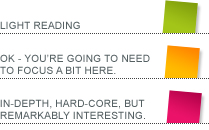We have previously posted about the different content platforms that are available online, and some thoughts on what type of writing is most suitable for each. I’d like to talk a bit more about crafting worthwhile content, in this and further posts.
I’m going to begin by talking mostly about written content. More specifically, about written paragraphs. But when we talk about content for the web we’re talking about menu titles, page titles, link naming, paragraphs of text, images, embedded media, and maps. (I may have left something off this list. It’s a long list.) I’ll cover some of these in later posts.
Planning your content
It’s a bit of a difficult thing to plan content for your website. On the one hand, your designer needs a clear idea of the kinds of content you need to include before they can think about the site architecture and page layouts. On the other hand, it really helps to source and consolidate content if you have some idea that you need information for an Company History page, a Services page and a Testimonials page.
The best way to handle this is to gather all the information you feel is important to include on your website before you consult with a web designer, then organise, edit and consolidate the information once you and the designer have agreed on the site architecture.
Using existing materials
Too often, content for a website is simply lifted from a company brochure or, even worse, delegated to an assistant to cobble together from various sources. This has its uses. Company brochures, generally, present a similar image of the company to that presented by your website. They are more formal and usually try for brevity – short, readable paragraphs. They also usually present the most vital information about the company organised in a sensible way, just as your website should try to do. However, while brevity is important (and more on this in a later post), you can, and should, make use of your website to provide somewhat more in-depth information.
Cobbled-together information, taken from brochures, annual reports and various other sources, can be used as an important basis for the content on your website, but that information should then be properly organised and rewritten so that it has a coherent style.
Thinking about keywords
Whether you’re using previously published content or newly written, it’s worthwhile to go over it and make sure some of your keywords are included in the content. If your company supplies rubber bands but nowhere in the content do you actually use the phrase ‘rubber bands’, the search engines are not going to place you highly for rubber bands just because the phrase is in your metatags. On the other hand, don’t overload your text with keywords. Gone are the days when pages of content that were ultimately rubbish loaded with variations on the same phrase could fool Google. The same goes for long lists of unrelated keywords floating at the bottom of your page.
Get a decent writer
If you have a marketing team or a staff member who really is a brilliant writer, by all means produce, edit and proofread your content in-house. However, please remember that when this content is online everyone in the world can read it. And there are many people out there who will turn their noses up at your services because there are terrible spelling errors all over your website. Careless copy makes you look like a careless company. Content is as much a part of your brand image as your logo. If you’re not 100% confident that your wife, nephew, accountant or even marketing manager can write, edit and proofread well enough, then have your content professionally written or edited to ensure that you protect your brand.


